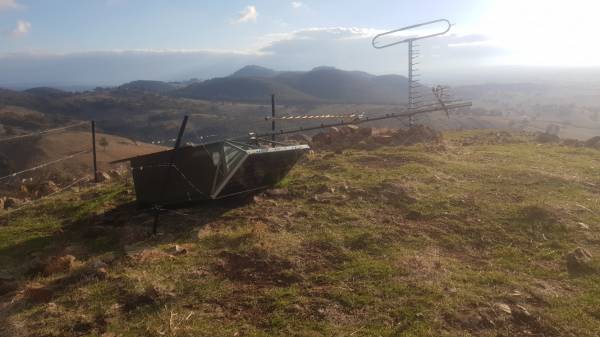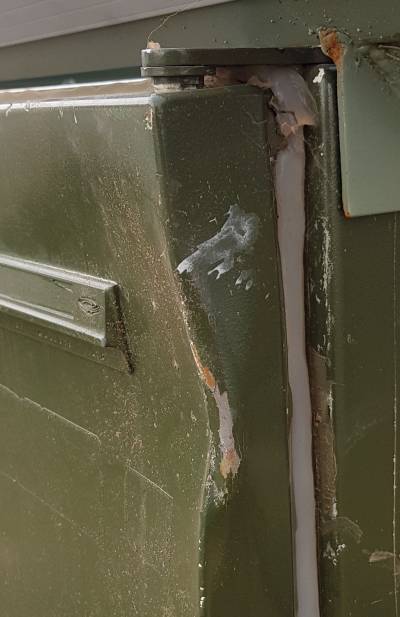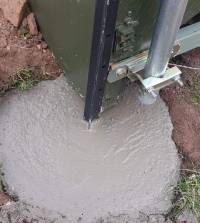VK3RWO forever surprising us.
In a previous article I wrote about making a new antenna for the 2m repeater at VK3RWO. I set about doing this as over the last month, the signals were notably weaker at my QTH. I put this down to we just had a lot of rain and all the trees etc were now natural attenuators.
Anyway, I packed a backpack of antenna tools and a couple of bits of test gear, put the new dipole over my shoulder and started the 7km walk UP the hill. About half way up I remembered that I had left my portable at the bottom of the hill in my van. Oh well I had a phone, and I knew both Gary VK2VU and Frank VK2BFC would be around for a test.
About 100m from the crest of the hill, Gary and I spoke on the phone so he could get some benchmark readings on some radios so he could tell me if there was any improvement. While on the phone I was looking in the direction of the repeater. I could see the fence to the compound, but, the next words out of my mouth were “Where is the f#$%ing repeater??” Up the hill I went, only to be confronted with this:

Not to be one to miss an opportunity, I unbolted the antenna and changed it while it was at head height, I thought its been this way for over a month, another 20 minutes is not going to make a difference. Now. The repeater cabinet weight in at 200kg, and has 4 star pickets, one in each corner. All of them were down into the ground about 3 feet. The front two had been bent, and the back two had been ripped out of the ground.. It must have been one hell of a gust of wind from the south to do that.
 The cabinet must have come down in a hurry, as evident by the damage to the door
The cabinet must have come down in a hurry, as evident by the damage to the door
The bit that has me perplexed the most: With the speed it fell, and angle of all the antennas, the NOT sealed batteries on their side and the solar panel looking at the ground, the bloody thing was still working…
THE REPEATER KEPT WORKING FOR A MONTH UP-SIDE-DOWN
Not trying to blow my own horn, but for any device to do that has certainly had the engineering put into it.
Given that I had not much more than a rusty old shifter, a couple of rags and an antenna analyser with me, I couldn’t do that much on the day, other than remove the legs, stand it back up, bash the legs back into the ground with a rock, secure the cabinet back to the legs with the shifter and then pile rocks against the door to prevent it falling over again.
Sometime in between all that, the telemetry unit stopped working, so I unbolted it from the frame and put it in the back pack, and off I wandered again, back down the hill.
Sunday morning, I decided that I need to do something about the repeater. I plugged the telemetry unit into my test bench, and found that it must have had a spike and lost its programming. Reprogrammed it and off it went again. Off to bunnings for a snag and some bags of rapid set concrete.
I loaded the van with crow bars, shovels, buckets, water containers, and well almost everything I could think of that I might need, and started the trek up the hill again. This trip was a bit easier considering I had more equipment.
It took 4 hours to dig several holes, mix concrete and pour it, then pile rocks onto the concrete to keep it there. The site is mostly sandy soil with chunks of sandstone in it, then after the first foot, turns to clay with quartz rock in it….. I certainly had my work cut out for me digging the holes.


The Telemetry unit got plugged back in and started reporting straight away as the door of the cabinet was wide open.
I then set about doing the maintenance (list below) that I would have done on my previous trip, had the thing not been upside down…..
Given that a repeater site has to look after itself, and it could be months between visits, here is a little list of the periodic maintenance that goes on, on a repeater site, particularly a solar powered one: Outside:
- Check and tighten the tension of all the antenna mountings
- Check and repair flying rat (cocky) damage
- Clean the solar panel
- Check the solar panel electrical connections
- Re-tension the fence, thanks skippy
- Spray the weeds
- Clean any fire hazards
Inside:
- Check for and remove unwanted house guests (snakes, rodents - however having said this, there will only be one or the other, not both!)
- Load test the batteries
- Check the tension and security of all RF connectors, particularly on the diplexer
- Check the antenna resonance
- Check the power output and frequency of the transmitters
On our site in particular:
- Load any firmware updates into the controllers
- check the telemetry is behaving and giving correct readings
- Sit back and have a beer, enjoying the view
Upon leaving:
- Lock the damn door
